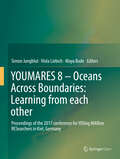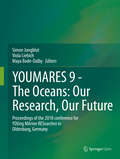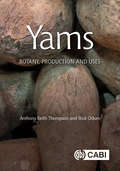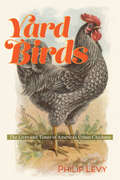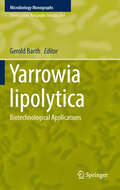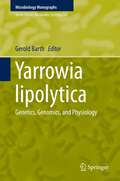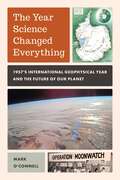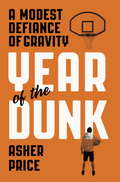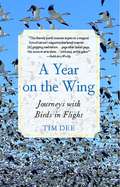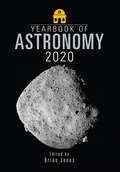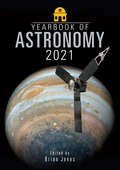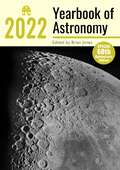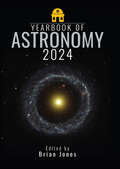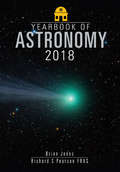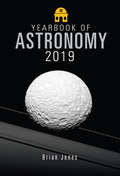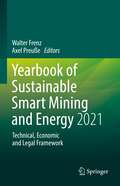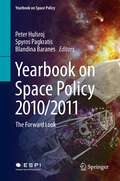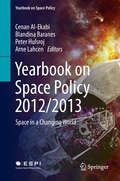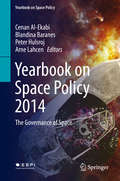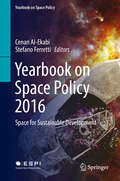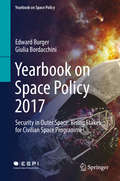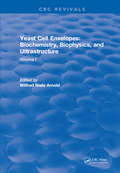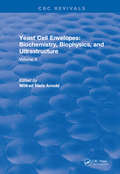- Table View
- List View
YOUMARES 8 – Oceans Across Boundaries: Proceedings Of The 2017 Conference For Young Marine Researchers In Kiel, Germany
by Simon Jungblut Viola Liebich Maya BodeThis open access book presents the proceedings volume of the YOUMARES 8 conference, which took place in Kiel, Germany, in September 2017, supported by the German Association for Marine Sciences (DGM). The YOUMARES conference series is entirely bottom-up organized by and for YOUng MARine RESearchers. Qualified early career scientists moderated the scientific sessions during the conference and provided literature reviews on aspects of their research field. These reviews and the presenters’ conference abstracts are compiled here. Thus, this book discusses highly topical fields of marine research and aims to act as a source of knowledge and inspiration for further reading and research.
YOUMARES 9 - The Oceans: Proceedings of the 2018 conference for YOUng MArine RESearcher in Oldenburg, Germany
by Simon Jungblut Viola Liebich Maya Bode-DalbyThis open access book summarizes peer-reviewed articles and the abstracts of oral and poster presentations given during the YOUMARES 9 conference which took place in Oldenburg, Germany, in September 2018. The aims of this book are to summarize state-of-the-art knowledge in marine sciences and to inspire scientists of all career stages in the development of further research. These conferences are organized by and for young marine researchers. Qualified early-career researchers, who moderated topical sessions during the conference, contributed literature reviews on specific topics within their research field.
Yams: Botany, Production and Uses (Botany, Production and Uses)
by Anthony Keith Thompson Professor Ibok OduroDioscorea species, commonly known as yams, are tuberous plants that constitute a major staple food in many parts of Africa, South East Asia, Latin America and the South Pacific. Yams are cultivated in about 50 mainly tropical countries, and the world annual production of edible tubers is around 73 million tonnes. This book evaluates the current state of knowledge about yams, and how this knowledge affects practices in production, cultivation and postharvest technology. Dioscorea is a diverse genus in terms of its geographical origin, domestication, morphology, chemistry and breeding. Therefore, besides concentrating on the dozen or so species that are used as major food crops, the book examines species that have limited commercial or domestic value at present, but have the potential in future to contribute to the production and utilization of this crop. This book: · Covers botany, taxonomy, composition, uses, cultivation, handling, storage, diseases, pests and production. · Describes the yam industry in the main producer countries, and around 100 of the most commonly grown species. · Reviews many Dioscorea species that may be developed in the future. It is an essential resource for researchers in horticulture, yam growers, breeders and postharvest technologists.
Yard Birds: The Lives and Times of America’s Urban Chickens
by Philip LevyIn 2009, the New Yorker declared chickens the "it bird" and heralded "the return of the backyard chicken." This honor occurred as, a host of American cities were changing their laws to allow chickens in residents’ backyards. Philip Levy, a sometime chicken keeper himself, mixes cultural history with husbandry to chronicle the weird and wonderful story of Americans’ urban chickens. From the streets of Brooklyn to council chambers in Albany to the beat of Key West’s Chicken Nuisance Patrol, yard birds are an important and growing part of American city life.Part history, part travelogue, and part reportage, Yard Birds takes the reader on a tour-de-force journey across America, past and present, to profile its urban chickens housed in luxury coops or dying at yearly rituals. What emerges is a compelling picture of city chickens that can both serve as hipster status symbols and guarantee that the families keeping them have at least something to eat. Levy’s smart and entertaining investigation of the contemporary urban chicken craze reveals that poultry flocks were historically an integral part of America’s urban spaces; chickens have simply returned home now, some to very fancy roosts.
Yarrowia lipolytica: Biotechnological Applications
by Gerold BarthDue to various special physiological features and a genome that greatly differs in structure, gene content and organization from other yeasts, Y. lipolytica is widely used as a host system. With its characteristics, such as the ability to grow on lipids or grease, to accumulate oil and the high capacity for secretion of proteases and lipases, the yeast is of great interest for biotechnological applications. The main topics covered in this Microbiology Monograph are: expression and secretion of heterologous proteins; acid and alkaline extracellular proteases; genetics, production, biochemical characterization and biotechnological application of lipases; production and secretion of several organic acids and flagrances; as well as the functional expression of P450 systems and its use in steroid biotransformation.
Yarrowia lipolytica: Genetics, Genomics, and Physiology
by Gerold BarthDue to various special physiological features and a genome that greatly differs in structure, gene content and organization from other yeasts, Y. lipolytica is widely used as a model organism. With its characteristics, such as the ability to accumulate oil and the high capacity for secretion of proteases and lipases, the yeast is also of great interest for biotechnological applications. The main topics covered in this Microbiology Monograph are: comparative genomics; mitochondrial genomics and proteomics, including the analysis of the respiratory chain; transposable elements and their activities; non-coding RNA genes, which display a number of unusual and remarkable features compared to other hemiascomycetes; utilization of hydrophobic substrates, of n-alkane and its oxidized derivatives as sources of carbon and energy; ambient pH signalling; comparison of protein families in non-conventional yeasts and S. cerevisiae; and the sulphur metabolism of cheese-ripening yeast. .
Year Science Changed Everything: 1957's International Geophysical Year and the Future of Our Planet
by Mark O'ConnellIn 1957, 6,000 scientists from 66 nations achieved the impossible: they erased political borders for 18 months to unlock Earth's greatest mysteries—and changed science forever. The International Geophysical Year (IGY) of 1957 marked humanity's first unified effort to understand our planet, launching the space race, discovering the Van Allen radiation belts, and producing groundbreaking climate research that shapes our world today. Through exclusive interviews with modern climate leaders—including the late marine biologist and climate researcher Dr. Wallace J. Nichols, science diplomat and Senior Fellow at United Nations Institute for Training and Research Paul Arthur Berkman, Frank Niepold at the National Oceanic & Atmospheric Administration (NOAA), science historian Rebecca Charbonneau, and many more—author Mark O'Connell reveals how this historic collaboration offers a blueprint for tackling today's environmental challenges. Key discoveries from this groundbreaking initiative: Sparked the space race and satellite technology development Led to the first comprehensive mapping of ocean floors Produced the Antarctic Treaty, protecting an entire continent Established the foundation for modern climate science Created a model for international scientific cooperation As climate change threatens our planet, The Year Science Changed Everything shows how the spirit of global scientific unity that transformed 1957 might be our best hope for safeguarding Earth's future.
Year of the Dunk
by Asher PriceBy embarking on a quest to dunk a basketball at the age of 34, journalist Asher Price investigates the limits of human potential--starting with his own. We all like to think that (with a little practice) we could run faster, learn another language, or whip up a perfect soufflé. But few of us ever put those hopes to the test. In Year of the Dunk, Asher Price does, and he seizes on basketball's slam dunk--a feat richly freighted with distinctly American themes of culture, race, and upward mobility--as a gauge to determine his own hidden potential. The showmanship of the dunk mesmerized Asher as a child, but even with his height (six foot plus) and impressive wingspan, he never pushed himself to try it. Now, approaching middle age, Asher decides to spend a year remaking his body and testing his mind as he wonders, like most adults, what untapped talent he still possesses. In this humorous and often poignant journey into the pleasures and perils of exertion, Asher introduces us to a memorable cast of characters who help him understand the complexity of the human body and the individual drama at the heart of sports. Along the way he dives into the history and science of one of sports' most exuberant acts, examining everything from our genetic predisposition towards jumping to the cultural role of the slam dunk. The year-long effort forces him to ask some fundamental questions about human ability and the degree to which we can actually improve ourselves, even with great determination.From the Hardcover edition.ve ourselves.From the Hardcover edition.
Year on the Wing
by Tim DeeBirds--those "upgiven ghosts" who shape our skies--and their many styles of flying have inspired us for centuries. Enthralled with birds since he was a young boy, Tim Dee describes their allure in compelling, poetic prose as he follows these magnificent creatures on land, at sea, and in the air over the course of a year. A memoir of the author's life as well as a stirring account of bird migrations and the enticements of flight, the book explores the ideas and feelings that birds awaken by their flying. A Year on the Wing is also a significant chronicle of Dee's rich reading of a gorgeous literary and naturalist tradition about birds, and achieves a marvelous commingling of nature and language, finding meaning and a fascinating beauty in the quiver of a redstart's tail, in the thrilling skydiving stoop of the once-endangered now resurgent peregrine falcon, and the nocturnal restlessness of migrant woodcocks. Watching birds instills a renewed sense of wonder in us all, and this beautifully written memoir celebrates birds and the inspiration they give as it expands our horizons.e inspiration they provide through their twice-yearly winged migrations.
Yearbook of Astronomy 2020
by Brian JonesThe celebrated annual for sky-watchers and stargazers, including references and a variety of fascinating articles. The Yearbook of Astronomy series is known for its comprehensive jargon-free monthly sky notes and authoritative sky charts that enable backyard astronomers and sky-gazers everywhere to plan their viewing of the year&’s eclipses, comets, meteor showers, and minor planets, as well as detailing the phases of the moon and visibility and locations of the planets throughout the year. Every annual edition also includes a variety of entertaining and informative articles. Among the wide-ranging articles in this edition are: 200 Years of the Royal Astronomical SocietyThe Naming of StarsAstronomical SketchingDark Matter and GalaxiesEclipsing BinariesThe First Known Black HoleA Perspective on the Aboriginal View of the World, and more First appearing in 1962, shortly after the dawning of the Space Age, Yearbook of Astronomy continues to be essential reading for any sky-watcher or stargazer, amateur and professional alike, who wants to expand their knowledge of the universe and its wonders.
Yearbook of Astronomy 2020
by Brian JonesThe celebrated annual for sky-watchers and stargazers, including references and a variety of fascinating articles. The Yearbook of Astronomy series is known for its comprehensive jargon-free monthly sky notes and authoritative sky charts that enable backyard astronomers and sky-gazers everywhere to plan their viewing of the year&’s eclipses, comets, meteor showers, and minor planets, as well as detailing the phases of the moon and visibility and locations of the planets throughout the year. Every annual edition also includes a variety of entertaining and informative articles. Among the wide-ranging articles in this edition are: 200 Years of the Royal Astronomical SocietyThe Naming of StarsAstronomical SketchingDark Matter and GalaxiesEclipsing BinariesThe First Known Black HoleA Perspective on the Aboriginal View of the World, and more First appearing in 1962, shortly after the dawning of the Space Age, Yearbook of Astronomy continues to be essential reading for any sky-watcher or stargazer, amateur and professional alike, who wants to expand their knowledge of the universe and its wonders.
Yearbook of Astronomy 2021
by Brian JonesThe annual treasury for sky-watchers and stargazers, including references and a variety of fascinating articles.The Yearbook of Astronomy series is renowned for its comprehensive jargon-free monthly sky notes and authoritative sky charts that enable backyard astronomers and sky-gazers everywhere to plan their viewing of the year’s eclipses, comets, meteor showers, and minor planets, as well as detailing the phases of the moon and visibility and locations of the planets throughout the year. Every annual edition also includes a variety of entertaining and informative articles. Among the wide-ranging articles in this 2021 edition are:Male Family Mentors for Women in AstronomyHenrietta Swan Leavitt and Her WorkSolar ObservingObsolete ConstellationsLunar VolcanismPages From the Past: Collecting Vintage Astronomy BooksMaori Astronomy in Aotearoa-New Zealand, and moreIn addition you’ll find the first in a series entitled Mission to Mars: Countdown to Building a Brave New World, scheduled to appear in the Yearbook throughout the 2020s to keep you fully up to date with the ongoing investigations, research, and preparations that are already underway, as well as those in the planning phase, geared towards sending a manned mission to Mars around the end of the decade. We are at the start of what promises to be an exciting journey—and the Yearbook of Astronomy continues to be an essential companion.
Yearbook of Astronomy 2022
by Brian JonesThe Yearbook of Astronomy 2022 is the Diamond Jubilee edition of this iconic publication, the annual appearance of which has been eagerly anticipated by astronomers, both amateur and professional, ever since this invaluable book first appeared in 1962. As the preface to the 1962 edition informed its readers, the post-war years had seen a tremendous growth of interest in astronomy and space research. Doubtless fueled by the dawn of the Space Age, the launch of Sputnik 1 in October 1957 marked a significant change in the course of history. This epoch-making event, coupled with the subsequent flights of Soviet cosmonaut Yuri Gagarin (April 1961) and American astronaut Alan Shepard (May 1961), served to engender a public interest in astronomy and space that has continued to grow and expand to this day. Maintaining its appealing style and presentation, the Yearbook of Astronomy 2022 contains comprehensive jargon-free monthly sky notes and an authoritative set of sky charts to enable backyard astronomers and sky gazers everywhere to plan their viewing of the year’s eclipses, comets, meteor showers and minor planets as well as detailing the phases of the Moon and visibility and locations of the planets throughout the year. To supplement all this is a variety of entertaining and informative articles, a feature for which the Yearbook of Astronomy is known. In the 2022 edition, the reader is presented with articles covering a wide range of topics including "A History of the Amateur Astronomical Society: 1962 to 2022"; "Expanding Cosmic Horizons"; "Frank Drake and His Equation"; "Remote Telescopes"; "Skies Over Ancient America" and others. The Yearbook of Astronomy continues to be essential reading for anyone lured and fascinated by the magic of astronomy. It remains an inspiration to amateur and professional astronomers alike, and warrants a place on the bookshelf of all stargazers and watchers of the Universe.
Yearbook of Astronomy 2024
by Brian JonesMaintaining its appealing style and presentation, the Yearbook of Astronomy 2024 contains comprehensive jargon-free monthly sky notes and an authoritative set of sky charts to enable backyard astronomers and sky gazers everywhere to plan their viewing of the year’s eclipses, comets, meteor showers and minor planets as well as detailing the phases of the Moon and visibility and locations of the planets throughout the year. To supplement all this is a variety of entertaining and informative articles, a feature for which the Yearbook of Astronomy is known. Presenting the reader with information on a wide range of topics, the articles for the 2024 edition include, among others, Recent Advances in Astronomy; Recent Advances in Solar System Exploration; Riccardo Giacconi: X-ray Astronomy Pioneer; Things Fall Apart – Chaos in the Solar System; Communicating From the Edge of the Solar System; Astronomy in Antarctica; Tracking Older Artificial Satellites; Inner Lives of Dead Stars; and A Triumvirate of Telescope Makers – Thomas Cooke, Howard Grubb and Alvan Clark. This iconic publication made its first appearance way back in 1962, shortly after the dawning of the Space Age. Now into its seventh decade of production, the Yearbook continues to be essential reading for anyone lured and fascinated by the magic of astronomy and who has a desire to extend their knowledge of the Universe and the wonders to which it plays host. The Yearbook of Astronomy is indeed an inspiration to amateur and professional astronomers alike, and warrants a place on the bookshelf of all stargazers and watchers of the skies.
Yearbook of Astronomy, 2018
by Brian Jones Richard S. PearsonThe YEARBOOK OF ASTRONOMY 2018 is a book no stargazer should be without.Recognized by both amateurs and professionals alike as an indispensable guide to the night sky, the Yearbook of Astronomy is one of the longest-running series of books on astronomy and the night sky and one of the only reference books to be fully revised each year. Formerly edited by Patrick Moore, this iconic publication first appeared way back in 1962 (well over half-a-century ago) and continues to be, as it was then, the main popular astronomy annual for amateur astronomers.Forthcoming editions will endeavor to maintain the popular style and familiarity of previous editions as well as offering its readers a new, invigorating and inspirational layout and presentation. The 2018 edition contains authoritative sky charts and detailed monthly sky notes that plot a clear path though the years lunar phases, eclipses, comets, meteor showers and minor planets as well as featuring a variety of articles covering a wide range of astronomy-related topics.Articles for the 2018 edition include: Solar System Exploration in 2017 by Peter Rea; Astronomy in 2017 by Rod Hine; Anniversaries in 2018 by Neil Haggath; Supermassive Black Holes by David M Harland; Comets and How to Photograph Them by Damian Peach; Some Pioneering Lady Astronomers by Mike Frost; Double and Multiple Stars by John McCue; Modern Video Astronomy by Steve Wainwright; Is There Still a Place for Art in Astronomy? by David A Hardy; and much more. Bursting with up-to-the-minute information, this Yearbook of Astronomy 2018 is, as ever, essential reading for anyone fascinated by the night sky . . .
Yearbook of Astronomy, 2019
by Brian JonesAn inspiration to amateur and professional astronomers alike, the Yearbook of Astronomy warrants a place on the bookshelf of all sky watchers and stargazers. Maintaining its appealing style and presentation, the Yearbook of Astronomy 2019 contains an authoritative set of sky charts and comprehensive jargon-free monthly sky notes to enable backyard astronomers everywhere to plan their viewing of the years eclipses, comets, meteor showers and deep sky objects.In addition, a variety of entertaining and informative articles present the reader with information on a wide range of topics including, among others, The Cassini-Huygens Mission to the Saturn System; 100 Years of the International Astronomical Union; The First Micro-Quasar; Getting the Measure of Double Stars; Asaph Hall: Man of Mars; and Science Fiction and the Future of Astronomy.The Yearbook of Astronomy has been around for well over half a century and, as it heads towards its Diamond Jubilee edition in 2022, continues to be essential reading for anyone lured by the magic of astronomy and who wants to extend their knowledge of the Universe and the wonders it plays host to.
Yearbook of Sustainable Smart Mining and Energy 2021: Technical, Economic and Legal Framework (Yearbook of Sustainable Smart Mining and Energy - Technical, Economic and Legal Framework #1)
by Walter Frenz Axel PreußeThis book is at the center of the UN goals of combining environment and economic development with new technologies.First, sustainability in mining is defined as a process of transformation. This is followed by an outlook on the aspects of safety, economy, environmental impact and digital transformation. The book includes a discussion of new aspects such as the problem of liability for mining damages regarding climate change in Peru. Specific technical issues in smart mining are covered as well, such as underground localization systems based on ultra-wide band radio and inertial navigation, or the use of thermal imaging for roof crack detection. In addition, the characterization of material flows, subsurface hydrogen-storage systems and the prediction of mining induced subsidence and uplift are dealt with.The Sustainable Smart Mining and Energy Yearbook is not only aimed at researchers professionals, but at all who want to get an overview of the important technical and legal topics in this field.
Yearbook on Space Policy 2010/2011
by Peter Hulsroj Blandina Baranes Spyros PagkratisThe Yearbook on Space Policy is the reference publication analysing space policy developments. Each year it presents issues and trends in space policy and the space sector as a whole. Its scope is global and its perspective is European. The Yearbook also links space policy with other policy areas. It highlights specific events and issues, and provides useful insights, data and information on space activities. The Yearbook on Space Policy is edited by the European Space Policy Institute (ESPI) based in Vienna, Austria. It combines in-house research and contributions of members of the European Space Policy Research and Academic Network (ESPRAN), coordinated by ESPI. The Yearbook is designed for government decision-makers and agencies, industry professionals, as well as the service sectors, researchers and scientists and the interested public.
Yearbook on Space Policy 2011/2012
by Peter Hulsroj Cenan Al-Ekabi Blandina Baranes Arne LahcenThe Yearbook on Space Policy is the reference publication analyzing space policy developments. Each year it presents issues and trends in space policy and the space sector as a whole. Its scope is global and its perspective is European. The Yearbook also links space policy with other policy areas. It highlights specific events and issues, and provides useful insights, data and information on space activities. The Yearbook on Space Policy is edited by the European Space Policy Institute (ESPI) based in Vienna, Austria. It combines in-house research and contributions of members of the European Space Policy Research and Academic Network (ESPRAN), coordinated by ESPI. The Yearbook is designed for government decision-makers and agencies, industry professionals, as well as the service sectors, researchers and scientists and the interested public.
Yearbook on Space Policy 2014
by Peter Hulsroj Cenan Al-Ekabi Blandina Baranes Arne LahcenThe Yearbook on Space Policy, edited by the European Space Policy Institute (ESPI), is the reference publication analysing space policy developments. Each year it presents issues and trends in space policy and the space sector as a whole. Its scope is global and its perspective is European. The Yearbook also links space policy with other policy areas. It highlights specific events and issues, and provides useful insights, data and information on space activities. The first part of the Yearbook sets out a comprehensive overview of the economic, political, technological and institutional trends that have affected space activities. The second part of the Yearbook offers a more analytical perspective on the yearly ESPI theme and consists of external contributions written by professionals with diverse backgrounds and areas of expertise. The third part of the Yearbook carries forward the character of the Yearbook as an archive of space activities. The Yearbook is designed for government decision-makers and agencies, industry professionals, as well as the service sectors, researchers and scientists and the interested public.
Yearbook on Space Policy 2016: Space For Sustainable Development (Yearbook On Space Policy Ser.)
by Cenan Al-Ekabi Stefano FerrettiThe Yearbook on Space Policy, edited by the European Space Policy Institute (ESPI), is the reference publication analysing space policy developments. Each year it presents issues and trends in space policy and the space sector as a whole. Its scope is global and its perspective is European. The Yearbook also links space policy with other policy areas. It highlights specific events and issues, and provides useful insights, data and information on space activities. The first part of the Yearbook sets out a comprehensive overview of the economic, political, technological and institutional trends that have affected space activities. The second part of the Yearbook offers a more analytical perspective on the yearly ESPI theme and consists of external contributions written by professionals with diverse backgrounds and areas of expertise. The third part of the Yearbook carries forward the character of the Yearbook as an archive of space activities. The Yearbook is designed for government decision-makers and agencies, industry professionals, as well as the service sectors, researchers and scientists and the interested public.
Yearbook on Space Policy 2017: Security in Outer Space: Rising Stakes for Civilian Space Programmes (Yearbook on Space Policy)
by Edward Burger Giulia BordacchiniThe book describes the recent trends in space policy and the space sector overall. While maintaining a global scope with a European perspective, it links space policy with other policy areas, highlights major events, and provides insights on the latest data. The Yearbook includes the proceedings of ESPI's 12th Autumn Conference, which discussed the growing importance of Security in Outer Space and the stakes for civilian space programmes in the public and private sectors. Bringing together satellite operators, SMEs, European and American institutions, and think tanks, the Autumn Conference served as platform for fresh insights on security in outer space and the potential of transatlantic relations to address its challenges. The Yearbook also includes executive summaries of ESPI's work in 2017 as well as ESPI's 2017 Executive Briefs, covering topics such as suborbital spaceflight, super heavy lift launch vehicles, collaboration with China, and the delimitation of outer space. All in all, the book gives a detailed review of space policy developments worldwide, contextualised with information about national-level space industries and activity and broader political and economic conditions. The readership is expected to include the staff of space agencies, the space industry, and the space law and policy research community.
Yeast Cell Envelopes Biochemistry Biophysics and Ultrastructure: Volume I
by Leo H ArnoldA comprehensive review of the yeast cell envelope has not appeared previously and therefore this book is timely. The title of this volume was chosen to reflect the three major areas of contribution to our current understanding of the cell envelope, but we have not attempted to group chapters into subdivisions. The approach was to describe phenomena, to review the literature and to illuminate outstanding problems. It was also attempted to generate working hypotheses which may stimulate further studies. The some of these ideas be of germinal value is of more concern to us than that all of the hypotheses should stand the test of further experimentation.
Yeast Cell Envelopes Biochemistry Biophysics and Ultrastructure: Volume II
by Leo H ArnoldA comprehensive review of the yeast cell envelope has not appeared previously and therefore this book is timely. The title of this volume was chosen to reflect the three major areas of contribution to our current understanding of the cell envelope, but we have not attempted to group chapters into subdivisions. The approach was to describe phenomena, to review the literature and to illuminate outstanding problems. It was also attempted to generate working hypotheses which may stimulate further studies. The some of these ideas be of germinal value is of more concern to us than that all of the hypotheses should stand the test of further experimentation.
Yeast Cytokinesis
by Alberto Sanchez-Diaz Pilar PerezThis volume presents protocols on yeast cytokinesis that will help Molecular and Cellular Biology researchers in the use of these microorganisms to approach the study of general or specific key questions in cytokinesis. Written for the Methods in Molecular Biology series, chapters include introductions to their respective topics, lists of the necessary materials and reagents, step-by-step, readily reproducible laboratory protocols, and tips on troubleshooting and avoiding known pitfalls. Authoritative and practical, Yeast Cytokinesis: Methods and Protocols provides practical and step-by-step detailed protocols useful for a wide audience ranging from experienced researchers to beginners in the use of yeasts.
